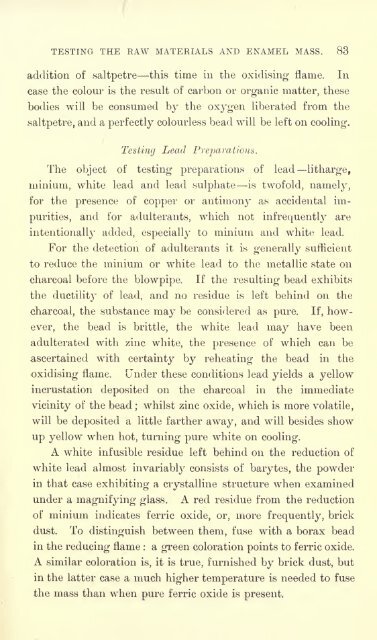Enamels and enamelling; an introduction to the preparation and ...
Enamels and enamelling; an introduction to the preparation and ...
Enamels and enamelling; an introduction to the preparation and ...
You also want an ePaper? Increase the reach of your titles
YUMPU automatically turns print PDFs into web optimized ePapers that Google loves.
TESTING THE RAW MATERIALS AND ENAMEL MASS. 83<br />
addition of saltpetre this time in <strong>the</strong> oxidising flame. In<br />
case <strong>the</strong> colour is <strong>the</strong> result of carbon or org<strong>an</strong>ic matter, <strong>the</strong>se<br />
bodies will be consumed by <strong>the</strong> oxygen liberated from <strong>the</strong><br />
saltpetre, <strong><strong>an</strong>d</strong> a perfectly colourless bead will be left on cooling.<br />
Testing Lead Preparations.<br />
The object of testing <strong>preparation</strong>s of lead litharge,<br />
minium, white lead <strong><strong>an</strong>d</strong> lead sulphate is twofold, namely,<br />
for <strong>the</strong> presence of copper or <strong>an</strong>timony as accidental im-<br />
purities, <strong><strong>an</strong>d</strong> for adulter<strong>an</strong>ts, which not infrequently are<br />
intentionally added, especially <strong>to</strong> minium <strong><strong>an</strong>d</strong> white lead.<br />
For <strong>the</strong> detection of adulter<strong>an</strong>ts it is generally sufficient<br />
<strong>to</strong> reduce <strong>the</strong> minium or white lead <strong>to</strong> <strong>the</strong> metallic state on<br />
charcoal before <strong>the</strong> blowpipe. If <strong>the</strong> resulting bead exhibits<br />
<strong>the</strong> ductility of lead, <strong><strong>an</strong>d</strong> no residue is left behind 011 <strong>the</strong><br />
charcoal, <strong>the</strong> subst<strong>an</strong>ce may be considered as pure. If, how-<br />
have been<br />
ever, <strong>the</strong> bead is brittle, <strong>the</strong> white lead may<br />
of which c<strong>an</strong> be<br />
adulterated with zinc white, <strong>the</strong> presence<br />
-ascertained with certainty by reheating <strong>the</strong> bead in <strong>the</strong><br />
oxidising flame. Under <strong>the</strong>se conditions lead yields a yellow<br />
incrustation deposited on <strong>the</strong> charcoal in <strong>the</strong> immediate<br />
vicinity of <strong>the</strong> bead ; whilst zinc oxide, which is more volatile,<br />
will be deposited a little far<strong>the</strong>r away, <strong><strong>an</strong>d</strong> will besides show<br />
up yellow when hot, turning pure white on cooling.<br />
A white infusible residue left behind on <strong>the</strong> reduction of<br />
white lead almost invariably consists of barytes, <strong>the</strong> powder<br />
in that case exhibiting a crystalline structure when examined<br />
under a magnifying glass. A red residue from <strong>the</strong> reduction<br />
of minium indicates ferric oxide, or, more frequently, brick<br />
dust. To distinguish between <strong>the</strong>m,<br />
fuse with a borax bead<br />
in <strong>the</strong> reducing flame : a green coloration points <strong>to</strong> ferric oxide.<br />
A similar coloration is, it is true, furnished by brick dust, but<br />
in <strong>the</strong> latter case a much higher temperature is needed <strong>to</strong> fuse<br />
<strong>the</strong> mass th<strong>an</strong> when pure ferric oxide is present.
















